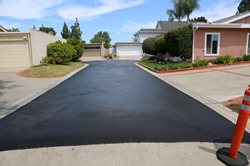Wednesday June 16, 2021
There are many important benefits to sealcoating your asphalt driveway or parking lot; protection from the elements, improved appearance, faster snowmelt and protection from caustic chemicals. Much like painting your home, waxing your car or staining a deck, you want a maintenance product that lengthens the life of your investment. A high-quality sealer that allows excellent coverage with a thin coating is the best step to protect, maintain and improve the overall appearance of asphalt.  The primary purpose of seal coating asphalt is to help slow down or even prevent long-term damage from the sun, sleet, snow, ice, hail and rain. Sun can wear down asphalt over time and rain can cause soft spots in the asphalt that can lead to cracking or potholes. Winters in the Midwest can take years off a driveway or parking lot’s life. A thin layer of seal coat applied every 2-3 years protects the asphalt from the initial damage of environmental elements. If left untreated, the sun will fade new asphalt to a dull grey color. Sealcoating improves the appearance of the asphalt. The extra layer makes the asphalt look clean, black and well maintained, adding to the curb appeal of your property. An additional benefit is the black sealer heats up faster and warmer in the winter, helping to increase the rate of snow and ice melting off your driveway or parking lot.
The primary purpose of seal coating asphalt is to help slow down or even prevent long-term damage from the sun, sleet, snow, ice, hail and rain. Sun can wear down asphalt over time and rain can cause soft spots in the asphalt that can lead to cracking or potholes. Winters in the Midwest can take years off a driveway or parking lot’s life. A thin layer of seal coat applied every 2-3 years protects the asphalt from the initial damage of environmental elements. If left untreated, the sun will fade new asphalt to a dull grey color. Sealcoating improves the appearance of the asphalt. The extra layer makes the asphalt look clean, black and well maintained, adding to the curb appeal of your property. An additional benefit is the black sealer heats up faster and warmer in the winter, helping to increase the rate of snow and ice melting off your driveway or parking lot.Most commercial seal coat companies will also provide a hot rubber crack sealant as an option for your asphalt. As water enters cracks in the asphalt, it permeates the base under it. The strength of the base will be diminished, leading to low areas, usually by garage doors and formation of potholes where vehicles are driven. Cracks filled with water are also susceptible to damage from freezing in cold climates. As the days become warmer in spring and summer, weeds and grass can grow up through the cracks, causing more damage to the asphalt and can give an unkempt appearance. Proper timing and taking the correct steps will lead to professional results.
Steps:
- Always apply a high-quality sealer in thin coats for driveways or two thinly sprayed coats for larger roads and parking lots. Using a brush will push the product into porous asphalt, increasing its wear life and giving the sealcoat a uniform textured surface. Spraying two thin coats on larger asphalt surfaces also allows for good coverage while not over spraying thick areas that tend to bond to themselves and not to the asphalt when drying.
- Apply seal coat in the evening when temperatures are over 50 degrees to allow for proper bonding of the sealer.
- For best results, allow for a 24-hour dry time in mid-summer and cooler evenings, or 48-hour dry time in the spring and fall.